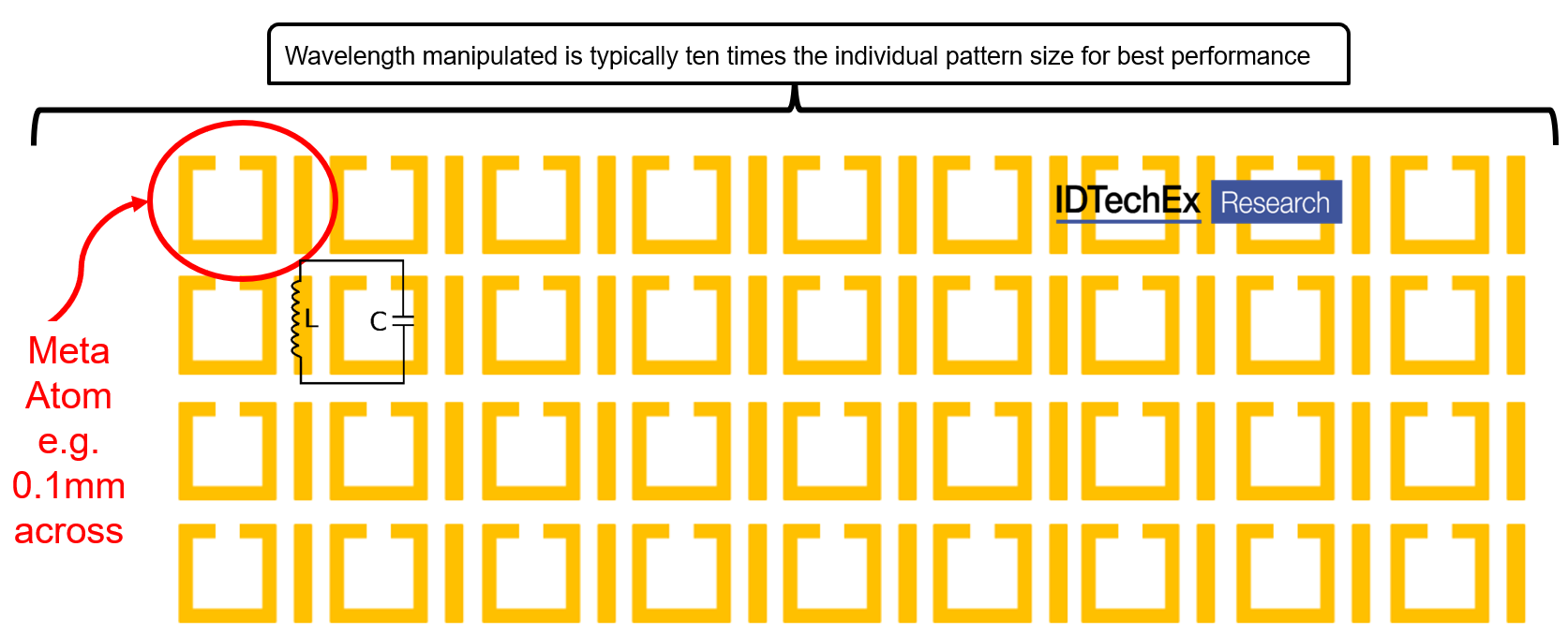The multi-billion business useful for 6G communications
Metamaterials are added-value materials. The IDTechEx report, 'Metamaterial and Metasurface Markets Electromagnetic 2022-2042' helps you prosper by making and deploying them everywhere. Who should you partner with, emulate or buy? Metamaterials are structures with repetitive patterning controlling radiation and other inputs in a previously impossible fashion.
Those inputs are mainly electromagnetic but can be mechanical or acoustic, for example. Most importantly, think lower cost, weight and size and better performance and life. That is within the megatrend to multi-functional laminar electronics and electrics achieving the previously impossible. Some are flexible and some load-bearing to replace dumb structures. Consider the new metaradomes protecting but now enhancing conventional radars.
Currently, microwave frequencies of tens of GHz are a focus because that is your 5G mobile phone system and a lot of radar, from driverless cars to military targetting. Each repeated pattern is called a meta-atom because it behaves rather like an atom when about one-tenth of the wavelength is being manipulated. For example, negative permittivity and negative magnetic permeability can give negative refractive index bending light and other radiation the wrong way.
Active components like diodes and transistors can be put in or behind each repeated pattern for greater virtuosity such as planned beam boosting, steering and focusing to your phone and even powering it as you use it. 6G communications in 2030 needs those metasurfaces over buildings, even inside walls. However, these cleverer things require active components like improved diodes and transistors near each pattern, later printed. Add computational, power supply, and other layers. Call them metasurfaces.
Be invisible? Transparent radiation shields will let you see clearly into your next microwave oven. Make things invisible? They are on the new Chinese stealth fighter. Replace large moving parts such as radar or a telephoto lens with little more than a sheet of plastic. Keep things cool with an infrared-juggling overlayer making your solar panels produce more electricity and your refrigerated truck use less electricity.
Businesses involving metasurfaces will now progress to becoming billion-dollar enterprises. That includes vertically-oriented ones making and using them for their security scanner, medical, or other activity. It also includes the newly-emerging need for horizontal marketing of optimised metasurfaces across all sectors as volumes make this worthwhile. For product quality, performance and affordability, the applicational-sector specialists must enter the very different world of optimised formulations, reel-to-reel manufacture, mass production themselves, or in partnership with those installing such capability.
Aspiring and actual participants need to learn the emerging materials and processing challenges, gaps in the market, competitor assessments, 20-year roadmaps, and forecasts in clear English. Sadly, for the latest situation, they face little more than a blizzard of mathematics and jargon in current literature.
The antidote is the unique report, 'Metamaterial and Metasurface Markets Electromagnetic 2022-2042' because it is entirely commercially oriented, not academic or historical. Grasp the optimal materials and manufacturing processes now needed, pros and cons, applications and potential uses of metamaterials whether alone, enhanced or product-integrated, best practice, best participants and benchmarking other industries. See blunt assessment of which volume applications and which specialist applications are really likely to happen.

The Executive Summary and Conclusions gives current and future situation including market forecasts and roadmap 2022-2042. Enjoy new infograms, graphs, and many pictures. 12 primary conclusions are given by IDTechEx PhD level analysts worldwide, many multi-lingual.
The Introduction clarifies the basics of metamaterials and 5G and 6G communications as potentially major users. The terminology nightmare is navigated. Grasp the versatility from energy harvesting to laminar everything but also the problem of power for widespread versions. The following chapters reveal the gaps in the market, the issues and the possibilities for those developing the compounds, manufacturing technologies and integrated products. They use new interviews and assessment of the latest research pipeline.
Chapter three covers metamaterial antennas, metaradomes, shielding, and sensors because these are among today's successes. Chapter four reports metamaterials and metasurfaces for visible, near-infrared, and thermal devices. Reconfigurable intelligent surfaces for planned 6G Communications are in chapter five followed by chapter six on ultra-fine-line metal patterning for metamaterials.
Those interested in the formulations involved in metasurfaces including higher-frequency transistors and diodes can read chapter seven on semiconductors, liquid crystals, dielectrics and graphene for metamaterials. Chapter eight then completes the report with the capability, strategy and IDTechEx SWOT appraisals of 18 metamaterial companies and the lesson of one failure.










